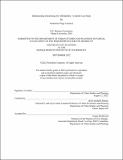Implementing (Up)Zoning for Affordability: A Seattle Case Study
Author(s)
Cameron, Nicholette Paige
DownloadThesis PDF (1.521Mb)
Advisor
bunten, devin michelle
Terms of use
Metadata
Show full item recordAbstract
Today, U.S. cities are continuing to grapple with housing shortages and the affordability crisis. In the United States, as of 2020, 30% of households were cost-burdened and 14% were severely cost-burdened, paying more than 30% and 50% of their incomes on housing, respectively. One way in which cities are attempting to manage growth and affordability is with zoning changes. Cities can encourage new development and increase affordable housing options by loosening restrictions that allow for more density and tying affordability requirements to that new development capacity. This is also known as inclusionary upzoning.
This thesis exists to document the case study of Seattle’s inclusionary upzoning policy, providing just one example of how cities are using zoning reform as a tool to address the affordability crisis. The case is presented as two components: Policy and Practice. The Policy section will provide an overview of the policy from ideation to implementation. First providing what steps were taken to implement both the upzone and the Mandatory Housing Affordability policy, including what buy-in was needed from various stakeholders. Second, it will outline how Seattle’s upzone and Mandatory Housing Affordability changed existing policy and if those changes impacted all neighborhoods equally. Lastly, it will provide a summary of what the policy had accomplished so far.
The Practice section provides one example of how a developer has responded to the upzone. I chose this developer because they are utilizing a unique, community-based model instead of the traditional purchase-to-redevelop business model, which allowed me to explore how the developer is supporting current residents and the community, and what challenges the developer and the community are experiencing as they navigate the upzone and MHA policy.
The thesis concludes with a set of recommendations that Seattle and other municipalities should consider when implementing [up]zoning reform for affordability, including implementing upzones citywide and changing the perspective of the role of communities in the development process.
Date issued
2022-09Department
Massachusetts Institute of Technology. Department of Urban Studies and PlanningPublisher
Massachusetts Institute of Technology